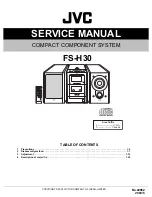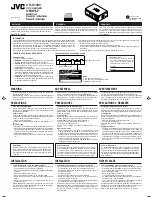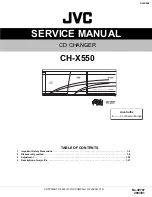
MAINTENANCE
WARNING!
TO REDUCE THE POTENTIAL FOR PERSONAL INJURY MAKE SURE THE MACHINE IS TURNED OFF AND HAS BEEN UN-
PLUGGED BEFORE PERFORMING ANY MAINTENANCE OPERATIONS.
Regular Maintenance
To ensure optimum performance and longer service life of your planer the following basic maintenance steps should be practiced regularly:
1) Inspect the power chord and plug for damage before each use. Never operate the planer with a damaged power chord or plug. To reduce the
risk of electric shock, unexpected start-up, and/or damage to the motor, replace a damaged power chord or plug immediately.
2) Test the ON/OFF switch before each use. Never operate the planer with a damaged/ malfuntioning switch. To reduce the risk of electric shock,
unexpected start-up, and/or damage to the motor, replace a damaged/malfunctioning switch immediately.
3) Keep the planer and its tables clean and free of debris, sawdust, woodchips, glue. Vacuum or brush off loose debris and wipe down the machine
regularly with a damp rag.
4) Regularly inspect freshly planed boards for signs of worn or damaged cutterhead inserts. Replace worn/damaged cutterhead inserts immedi-
ately.
5) An occasional light coating of paste wax can help protect the tables’ surface and reduce workpiece friction. Avoid using silicon based products
that may affect wood finishing products such as oil, solvent or water based stains, varnishes and lacquers.
6) The motor and cutterhead bearings are sealed and permanently lubricated, no further lubrication is required.
7) The drive gears, chain and elevation screws should be cleaned of woodchips, dust, debris and old grease after every 10-15 hours of use. After
cleaning, re-apply a generous coating of any common automotive bearing grease.
Replacing/Rotating Cutterhead Inserts
The cutterhead is equipped with 26 cutter inserts with 2 cutting surfaces each. To
maintain even wear and smooth planing results, always rotate or replace all 26 inserts
each time replacement is needed.
NOTE:
Original King Canada replacement cutter inserts (model KW-204) can be or-
dered through your local retailer.
WARNING!
MAKE SURE THE MACHINE HAS BEEN TURNED OFF AND UN-
PLUGGED FROM THE POWER SOURCE BEFORE PERFORMING ANY MAINTE-
NANCE OR ADJUSTMENTS.
Observing planed workpieces as they come off of the machine and looking for signs
of cutter insert damage or wear is the best method to help you to determine when
they are due to be changed. Signs to look for:
1) A raised ridgeline in the workpiece that runs a straight line from beginning to end
of the board. This is generally an indication that one or more cutter inserts have
been nicked or damaged by a foreign object such as a nail, staple or other hard
object hidden or embedded in the workpiece.
2) A slight washboard or chatter effect which can be an indication of uneven cutter in-
sert wear causing one cutter cuts slightly deeper than the others.
3) Rough, irregular, torn or fuzzy grain on a freshly planed surface may be a sign of
worn or dull cutter inserts causing the wood to tear out. Sharp cutter inserts cut
crisply and leave a relatively smooth finish.
Note: Fuzzy grain can also be a sign of high moisture content in the workpiece. If cutter inserts have recently been changed or if you suspect that
moisture content and not dull inserts is the cause, set the workpiece aside and test by planing other boards with known or acceptable moisture
content. If the planed results using a different workpiece are smooth, then moisture content in your wood is the problem. No adjustments can be
made to the machine for this. Set the “wet” stock aside and simply work with drier wood.
1) Turn off and unplug the machine from the power source and remove the switch safety key.
2) Remove the dust chute lock knobs (A) Fig.13 and remove the dust chute (B).
3) Remove the flat head allen screw (B) Fig.8 with the supplied 4 mm hex. key, then pull and slide the cover (C) downwards to remove it.
4) Insert the supplied 4 mm hex. key (A) Fig.14 into the cutterhead shaft (B) to immobilize the cutterhead shaft.
MAINTENANCE
FIGURE 13
FIGURE 14





























